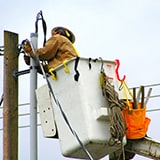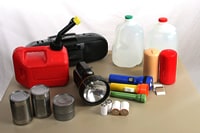
When the Electricity Goes Out
What to Do in a Power Outage

Power failures can strike suddenly without a care for your plans or activities. Some outages are brownouts, in which you experience a temporary interruption in voltage (i.e. the lights dim). Blackouts are complete absences of power that could last a day or more in the worst circumstances.
Knowing what to do when the power goes out can minimize the uncertainty and disruption to your life. It all starts with planning ahead.
How to Prepare For a Power Outage
There are some instances when power outages are planned. Brownouts and rolling blackouts are often deliberately implemented by power companies to cope with peak power demands and/or to prevent a worse blackout. Your utility company should alert you to planned outages.
For example, California utilities sometimes implement rolling blackouts to protect the grid and surroundings from raging wildfires.
Other causes of power outages include:
- Hurricanes
- Lightning strikes
- Downed lines
- An overloaded grid
- Transformer explosion
- Solar flares
- Updates and repairs to infrastructure
More than likely, a power outage will strike without warning due to inclement weather. At that point, you’re scrambling to figure out what to do when you could have had a plan in place all along.
Stock Up on Essentials

Have a gallon of water per person per day and nonperishable food stocked up ahead of time. We also recommend keeping these 25 items in your home during an emergency. Just knowing you have what you need to survive will reduce the stress and anxiety caused by a power outage.
Get Backup Power
A backup electric generator is one of the most important things you need during a power outage. It will make it seem like you don’t have a power outage at all, depending on what type you get.
Whole house and standby generators will turn on automatically when they detect a blackout. If properly sized, they can power most, if not all, equipment in your home during an outage. Once utility power comes back on, they automatically switch off.
Standbys are large, hardwired generators that cannot be installed overnight, so planning is necessary. Typically, your local municipality must approve the installation before you can get a professional contractor to your home.
Also, never backfeed or connect your generator directly to your home’s electrical system. Instead, connect appliances directly to the generator by running cords outside or via a manual transfer switch.
Stay Informed
Follow the news for weather threats and be aware of any planned power outages from your utility. Lightning, ice, and strong winds can all cause blackouts either directly or indirectly, so if these conditions are expected, be ready for the lights to go out.
What to Do During the Outage
As soon as the lights go out, there are a few steps you should take.
Find out what’s going on. Is the power outage affecting your neighbors, your neighborhood, or just you? Figuring out how widespread it is can help you appraise the severity. You should also report the outage to your power company to make sure they're aware.
Turn the battery-powered radio on that you have in your emergency kit, or track severe weather on social media. Both can help you figure out what is happening and when you can expect the lights back on.- Unplug your appliances. When the power comes back on, the initial surge can damage your appliances, especially if they’re not plugged into a surge protector. Electronics, such as TVs and computers, are particularly sensitive. To prevent damage, unplug everything as soon as the power goes out.
- Check your water. When the power goes out, water treatment centers might not be able to effectively purify your water. Contact them to find out, or keep your ears open for any boil alerts. If you have water stocked up, though, you shouldn’t have a problem.
- Conserve your phone’s battery. Your phone is your lifeline to the outside world. A power outage is not the time to waste battery life playing games like Candy Crush Saga or browsing the web. Unless you have a battery charger on hand, don’t use your phone carelessly.
- Stay Warm (Or cool). A power outage will most likely interrupt your home’s heating and cooling if you don’t have a backup generator. If it’s cold, dress in layers and use extra blankets. If it’s dangerously hot, either run a battery-powered fan or drive somewhere cool, like a library.
Many homeowners have questions when a power outage hits. Appliances we take for granted every day suddenly don’t work. Here are some frequently asked questions and recommendations.
Does Hot Water Work When Power is Out?
If it’s an electric tank or tankless model, then you’re out of luck. If you have a gas tank or tankless water heater, it will still need main power to switch the pilot light on and heat the water. Only a few, mostly older gas tank water heaters will continue to work.
If you need to shower during an outage, do so early on while the water in the tank is still hot. Once that water cools, that’s it.
Will My Gas Stove Work During a Power Outage?
You can still get a burner to work, however, by putting a match to it and turning the gas knob to the low position. The match will ignite the flame. Just be very careful doing this.
How Long Can Food Last in the Fridge Without Power?
When the power goes out, don’t open the fridge or freezer unless you really must. If you anticipate a prolonged outage, start eating the perishable foods in your fridge first so they don’t go to waste. Take out multiple items at once so you don’t have to open and close the door repeatedly.
Who Do You Call During a Power Outage?
Knowing who to call when power is out is extremely important. Do Not call 911 just to report a power outage unless you or someone in your home is hurt or in danger. It’s irresponsible to divert valuable 911 resources from the people who need them most.
How Do I Start My Generator?
If you prepared for an outage by buying a portable backup generator, congratulations! Your life will be much easier during the outage.
There are several steps and safety considerations to take before starting your generator, however. Read our generator quick start guide for all the details.
After the Outage
When the lights come back on, there are a few commonsense steps to take.
Check for Flooding
If your power outage accompanied a severe storm, you should check for basement flooding, especially if you didn’t have backup power and your sump pump went out. Check out our Ultimate Flooding Guide for help dealing with a flood.
With the power back on, you can start plugging in and turning on essential appliances again. Do so gradually to allow the system to stabilize. Then you can turn on your secondary electronics.
Clean Out Your Refrigerator
If the power outage lasted more than four hours, the perishable food in your fridge is no longer safe to eat, and you will have to throw it away before you forget. Remember, your freezer food should still be fine, unless the outage lasted for a day or more.
Get Ready for the Next Outage
If you went through the supplies in your home emergency kit, remember to restock for the next power outage. At this point, if you didn’t have a backup generator, you might appreciate its value even more. And don’t forget to reset your electric clocks because they stopped at the time of the outage!
Your power will turn back on eventually, and you'll be ok. Knowing what to do in between will reduce interruptions and unnecessary stress.
Hurricane Preparation Navigation
Main | Hurricane Supplies | Hurricane Shipping | Hurricane Generator Guide | Flood Protection | Dealing With Power Outages | Most Destructive Hurricanes | Hurricane Forecasts
